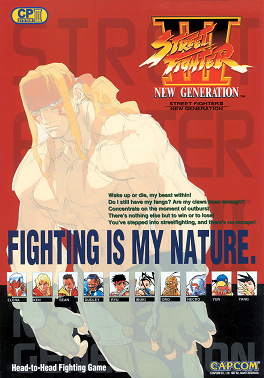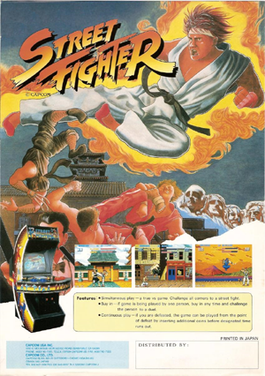A fighting game is a genre of video game that involves combat between two or more characters. Fighting game combat often features mechanics such as blocking, grappling, counter-attacking, and chaining attacks together into "combos". Characters generally engage in battle using hand-to-hand combat—often some form of martial arts. The fighting game genre is related to, but distinct from, the beat 'em up genre, which pits large numbers of computer-controlled enemies against one or more player characters.

Tetris Attack, also known as Panel de Pon in Japan, is a puzzle video game developed by Intelligent Systems and published by Nintendo for the Super Nintendo Entertainment System. A Game Boy version was released a year later. In the game, the player must arrange matching colored blocks in vertical or horizontal rows to clear them. The blocks steadily rise towards the top of the playfield, with new blocks being added at the bottom. Several gameplay modes are present, including a time attack and multiplayer mode.

In video games, a boss is a significantly powerful non-player character created as an opponent to players. A fight with a boss character is commonly referred to as a boss battle or boss fight. Bosses are generally far stronger than other opponents the players have faced up to that point in a game. Boss battles are generally seen at climax points of particular sections of games, such as at the end of a level or stage or guarding a specific objective. A miniboss is a boss weaker or less significant than the main boss in the same area or level, though usually more powerful than the standard opponents and often fought alongside them. A superboss is generally much more powerful than the bosses encountered as part of the main game's plot and is often an optional encounter. A final boss is often the main antagonist of a game's story and the defeat of that character usually provides a positive conclusion to the game. A boss rush is a stage where players face multiple previous bosses again in succession.

Street Fighter III: New Generation is a fighting game in Capcom's Street Fighter series, originally released as a coin-operated arcade game in 1997. The game's name as it appears on the cabinet is Three: A New Generation of Street Fighters. Street Fighter III was produced for the CD-ROM-based CP System III hardware, which allowed for more elaborate 2D graphics than the CPS II-based Street Fighter Alpha games, while revamping many of the play mechanics. The game, which was designed as a direct sequel to Street Fighter II, initially discarded every previous character except for Ryu and Ken, introducing an all-new roster led by Alex. Likewise, a new antagonist named Gill took over M. Bison's role from the previous games as the new boss character.
Super Smash Bros. is a crossover platform fighting game series published by Nintendo. The series was created by Masahiro Sakurai, who has directed every game in the series. The series is known for its unique gameplay objective which differs from that of traditional fighters, in that the aim is to increase damage counters and knock opponents off the stage instead of depleting life bars.

Fighters Destiny, known in Japan as Fighting Cup is a 1998 video game developed by Genki and Opus Corp for the Nintendo 64. It closely models the 3D fighting game standard set by Sega's Virtua Fighter, but integrates a unique point scoring system. The game's generic characters and unoriginal presentation have been panned by critics, but reviewers praise its point system and consider it to be one of the best fighting games on the Nintendo 64. It was followed by a 2000 sequel Fighter Destiny 2.

Street Fighter is a 1987 arcade fighting game developed and published by Capcom. It is the first competitive fighting game produced by the company and the first installment in the Street Fighter series. It was a commercial success in arcades and introduced special attacks and some of the conventions made standard in later fighting games, such as the six-button controls and the use of command-based special moves.

Street Fighter III: 2nd Impact - Giant Attack is a competitive fighting game produced by Capcom that was released as a coin-operated arcade game in 1997. It is an update of Street Fighter III: New Generation. Like its predecessor, it runs on the CP System III hardware. 2nd Impact introduced new gameplay mechanics, new characters, and new special moves. The game also brings back bonus rounds, not seen in the series since Super Street Fighter II. It is also the only CPS3 title to have a widescreen feature.

Super Smash Bros. Brawl is a 2008 crossover fighting game developed by Sora Ltd. and Game Arts and published by Nintendo for the Wii. The third installment in the Super Smash Bros. series, it was announced at a pre-E3 2005 press conference by Nintendo president Satoru Iwata. Masahiro Sakurai, director of the previous two games in the series, assumed the role of director at Iwata's request. Game development began in October 2005 with a creative team that included members from several Nintendo and third-party development teams. After delays due to development problems, the game was released worldwide in 2008.
David Sirlin is an American game designer and fighting game player.

Super Smash Bros. is a 1999 crossover fighting game developed by HAL Laboratory and published by Nintendo for the Nintendo 64. It was first released in Japan on January 21, 1999, in North America on April 26, 1999, and in Europe on November 19, 1999. The first installment in the Super Smash Bros. series, it is a crossover between several different Nintendo franchises, including Mario, The Legend of Zelda, Star Fox, Yoshi, Donkey Kong, Metroid, F-Zero, Mother, Kirby, and Pokémon. It presents a cast of characters and locations from these franchises and allows players to use each character's unique skills and the stage's hazards to inflict damage, recover health, and ultimately knock opponents off the stage.
Yomi: Fighting Card Game is a designer card game created by David Sirlin, inspired by Super Street Fighter II Turbo, which Sirlin also worked on. “Yomi” is Japanese for “reading,” as in reading the mind of the opponent. The Yomi card game is designed to distill the high-level mind games from fighting game into a simple card game. It features asymmetric gameplay, and makes use of cards with multiple options.

Arms is a 2017 fighting game developed and published by Nintendo for the Nintendo Switch. The game differentiates itself from standard fighting games with its unconventional fighting system where every playable character fights with long range attacks and up to four players can choose a fighter and battle using a variety of extendable, weaponized arms to knock out opponents in a three-dimensional arena. Arms received generally favorable reviews from critics and sold over two million copies by July 2018.

Ultra Street Fighter II: The Final Challengers is a fighting game developed and published by Capcom for the PlayStation 4, Xbox One, Nintendo Switch and Windows, which released worldwide on 26 May 2017 to celebrate the Street Fighter series' 30th anniversary. It is an updated version of 1994's Super Street Fighter II Turbo. The game features two graphical styles: classic pixel art and updated high-definition art. New gameplay mechanics and modes were also introduced, with minor changes being made to the game's balance. The game garnered mixed-to-positive reviews from critics, who praised its updated visuals, but criticized the $40 price, the Way of the Hado mode, and control problems.

Brawlout is a fighting game developed and published by Angry Mob Games for Microsoft Windows, Nintendo Switch, PlayStation 4, and Xbox One. The game was revealed at EVO in July 2016, and went into closed beta in December 2016. The game was initially released as early access for Microsoft Windows on April 20, 2017. Various outlets, such as Engadget, have compared Brawlout to the Super Smash Bros. series.

Dragon Ball FighterZ is a 2.5D fighting game developed by Arc System Works and published by Bandai Namco Entertainment. Based on the Dragon Ball franchise, it was released for the PlayStation 4, Windows, and Xbox One, in most regions in January 2018, and in Japan the following month, and was released worldwide for the Nintendo Switch in September 2018. Versions for PlayStation 5 and Xbox Series X/S were released in February 2024 alongside an update adding rollback netcode for these versions and Windows.

Street Fighter 30th Anniversary Collection is a compilation of fighting games from the Street Fighter series developed by Digital Eclipse and published by Capcom in celebration of the series' 30th anniversary. The collection was released for Nintendo Switch, PlayStation 4, Windows, and Xbox One in May 2018.

Super Smash Bros. Ultimate is a 2018 crossover fighting game developed by Bandai Namco Studios and Sora Ltd. and published by Nintendo for the Nintendo Switch. It is the fifth installment in the Super Smash Bros. series, succeeding Super Smash Bros. for Nintendo 3DS and Wii U (2014). The game follows the series' traditional style of gameplay, in which players control one of the various characters and use attacks to weaken their opponents and knock them out of an arena. It features a wide variety of game modes, including a single-player campaign and multiplayer versus modes. Ultimate features 89 playable fighters, including all characters from previous Super Smash Bros. games as well as newcomers. The roster ranges from Nintendo characters to those from third-party franchises.

Crystal Crisis is a competitive tile-matching puzzle video game developed and published by Nicalis, released on Nintendo Switch, PlayStation 4 and Microsoft Windows via Steam in 2019. It is inspired by Capcom's Super Puzzle Fighter II Turbo and features crossover appearances by several characters from other Nicalis video games, as well as additional guest characters from companies such as Tezuka Productions.

Nickelodeon All-Star Brawl is a 2021 crossover fighting game developed by Ludosity and Fair Play Labs, and published by GameMill Entertainment. It is part of the Nickelodeon Super Brawl series of browser games and mobile games, serving as its first console game. Featuring characters from various Nickelodeon animated television series, the game was released on October 5, 2021, for Nintendo Switch, PlayStation 4, PlayStation 5, Windows, Xbox One, and Xbox Series X/S. A sequel, Nickelodeon All-Star Brawl 2, released in 2023.















